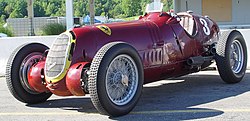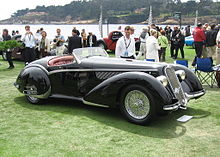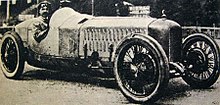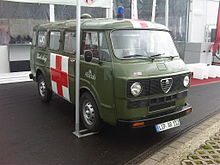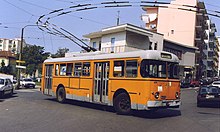Alfa Romeo
Founded on 24 June 1910 in Milan, Italy as A.L.F.A.—an acronym for Anonima Lombarda Fabbrica Automobili[a]—the company was established by Cavaliere Ugo Stella to acquire the assets of the ailing Italian subsidiary of French carmaker Darracq, of which he had been an investor and manager.
Through the 1920s, Alfa Romeo produced several successful road and race cars, and was well represented in prominent European motorsport events, notably winning the inaugural Grand Prix in 1925.
Despite its strong brand image and relatively sizeable share of the high-performance auto market in Europe, by the 1970s, the company was operating at a loss, prompting IRI to sell it to Fiat Group in 1986.
("Anonima Lombarda Fabbrica Automobili" - “Anonymous Lombardy Automobile Factory”), and the last name of entrepreneur Nicola Romeo, who took control of the company in 1915.
In 1914, an advanced Grand Prix car was designed and built, the GP1914, with a four-cylinder engine, double overhead camshafts, four valves per cylinder, and twin ignition.
In August 1915, the company came under the direction of Neapolitan entrepreneur Nicola Romeo, who converted the factory to produce military hardware for the Italian and Allied war efforts.
Smaller, mass-produced vehicles began to be produced beginning with the 1954 model year, with the introduction of the Giulietta series of berline (saloons/sedans), coupes and open two-seaters.
[13] During the 1960s, Alfa Romeo concentrated on motorsports using production-based cars, including the GTA (standing for Gran Turismo Allegerita), an aluminium-bodied version of the Bertone-designed coupe with a powerful twin-plug engine.
North American sales resumed in October 2008, with the launch of the limited production 8C Competizione coupe with Alfa Romeo models being imported by Fiat's US subsidiary Chrysler.
Instead, as reported by The Wall Street Journal in November 2009, Chrysler discontinued several Dodge and Jeep models while phasing in Alfa Romeo ones and the new Fiat 500.
[43] 1969 models for the North American market had SPICA (Società Pompe Iniezione Cassani & Affini, a subsidiary of Alfa Romeo) mechanical fuel injection.
[55] Many famous automotive design houses in Italy have accepted commissions to produce concepts and production vehicle shapes for Alfa Romeo.
In 1925, to commemorate the victory of the Alfa Romeo P2 in the inaugural World Manufacturers' Championship of 1925, a silver metal laurel wreath was added around the badge, used (in varying form) until 1982.
Other changes are a new serif type face, and the absence of the split white and light blue fields, replaced by a single silver textured background.
To banish his bad luck, when the Targa Florio came around, the driver painted a white square with a green four-leaf clover (the quadrifoglio) in the centre of the grille of his car.
Also in the 1970s and through the 1980s golden four-leaf clover badges were used to denote the most luxurious and well-equipped variants of Alfa Romeo cars, named "Quadrifoglio Oro" or "Gold Cloverleaf".
In the 1960s, the main Alfa Romeo factory was moved from inside Milan to a very large and nearby area extending over the municipalities of Arese, Lainate and Garbagnate Milanese.
The Alfa Romeos Brits plant was used from March 1983[72] until late 1985 to build Daihatsu Charades for local consumption, but also for export to Italy in order to skirt Italian limits on Japanese imports.
[74] In late 1985, with the impending Fiat takeover and an international boycott of the South African Apartheid government, Alfa Romeo withdrew from the market and closed the plant.
The Stelvio is Alfa Romeo's first production SUV that competes in the same category as the Porsche Macan, Jaguar F-Pace, Audi Q5, Mercedes-Benz GLC and BMW X3.
The Carabinieri Alfa Romeros are dark blue with white roofs and red stripes, known as the "Gazzella" (Gazelles), a nickname meant to denote the speed and agility of these "Pattuglie" (patrol cars).
However, the term "Pantera" came to be used interchangeably to refer to both agencies' vehicles, and helped create a public perception of the cars as no-nonsense, determined and respected.
Heavy trucks continued to be built for a few years in Brazil by Alfa Romeo subsidiary Fábrica Nacional de Motores under the name FNM.
Although Alfa Romeo is best known as automobile manufacturer it has also produced commercial vehicles of various size, railway locomotives,[6] tractors, buses, trams, compressors, generators, an electric cooker,[84] marine and aircraft engines.
[87] Alfa Romeo built various aircraft engines during the Second World War; the best known was the RA.1000 RC 41-I Monsone, a licensed version of the Daimler-Benz DB 601.
In the 1960s Alfa Romeo mainly focused upgrading and maintaining Curtiss-Wright, Pratt & Whitney, Rolls-Royce and General Electric aircraft engines.
[93] More recent slogans used are "Mediocrity is a sin", "Driven by Passion", "Cuore Sportivo", "Beauty is not enough" and present day "Without heart we would be mere machines".
[94] It has sponsored the SBK Superbike World Championship and Ducati Corse since 2007, and the Goodwood Festival of Speed for many years, and was one of the featured brands in 2010 when Alfa Romeo celebrated its 100th anniversary.
Presenters Jeremy Clarkson, Richard Hammond and James May continuously praised Alfas for their beauty and driving characteristics even though Italian cars had a long-term bad reputation for unreliability.
Alfa Romeo announced Zhou Guanyu as China's first Formula One racing driver for the 2022 season, hailed by both the team and the sport as a historic breakthrough in a key growth market.


